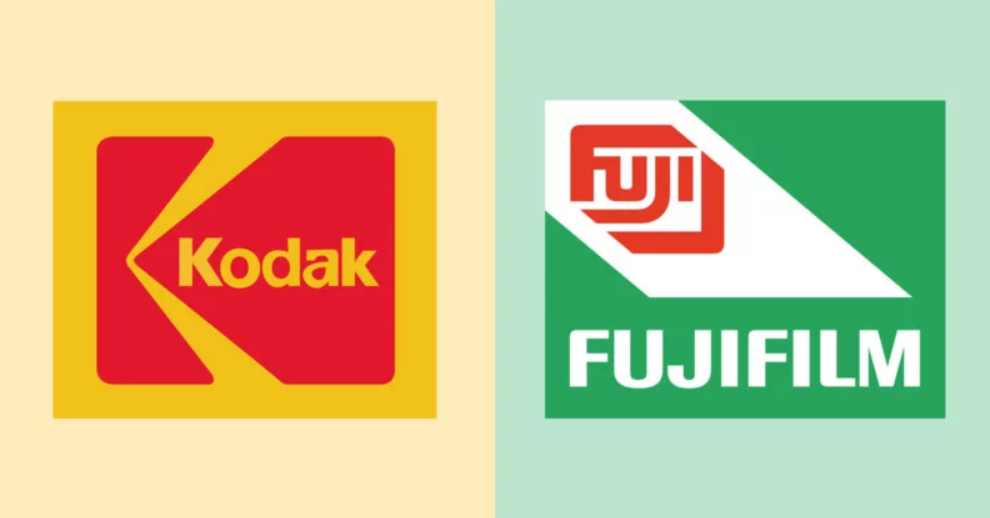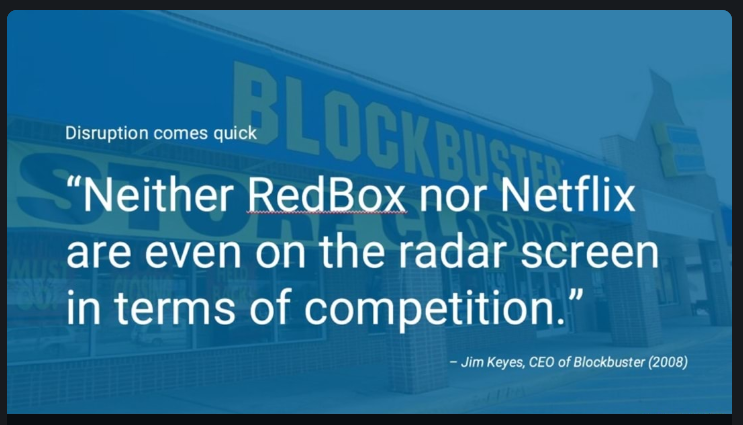Throughout the 80s and 90s time period, there was a strong competition in the point-and-shoot camera film industry amongst Canon, Fujifilm, and Kodak. But not all of these companies exactly saw the future of disruption coming with digital cameras and digital imaging photography, and how it would change the way people take and share photos.
And as these companies were facing innovation and change, some were able to adapt and pivot better. Avi Dan, a Forbes contributor mentioned, “It actually invented the first digital camera in 1975. However, instead of marketing the new technology, the company held back for fear of hurting its lucrative film business, even after digital products were reshaping the market.”
The development of digital imaging started to erode the revenue of Kodak’s business units in making film, chemical, paper, and film processing machinery.
By the year 1999, Kodak had become the number two in digital cameras production– the problem was, it was incurring a loss of $60 on each one it sold. Unfortunately, like in the past, the high margin on the sale of associated products like chemical or paper was absent in digital imaging to cover such losses. Unlike Kodak, the Japanese camera maker Canon saw an opening, charged ahead, and achieved profitability by producing, selling digital cameras and associated components, such as lenses. Sony also saw an opening and moved forward with their digital cameras.

(image credit: Petapixel)
Grant Thorton LLP wrote an interesting article about business disruption and they mention another company Fujifilm, which had worked very hard in the 90s to diversify its business away from film, by leveraging and building a new in-house tech talent expertise, to make the pivot to other industries such as cosmetics, semiconductors, and medical imaging technologies. In 2012, the Economist published an article, ‘How Fujifilm survived Sharper focus”. The author stated that “In contrast, Kodak seemed to believe that its core strength lay in its brand and marketing and that it could simply partner or buy its way into new industries, such as drugs or chemicals.” That obviously did not work very well.
If you look at the market cap of these companies today, Canon is worth $28 billion, Fujifilm is worth around $18 billion. In fact, at its peak, “Kodak captured 90% of the US film market and was one of the world’s most valuable brands,” but is now worth well under $1 billion.
As the Grant Thorton LLP article also mentions that “Fujifilm had made the decision that they weren’t a film company but an information company, and they were fine,” said Joshua Gans, professor of strategic management at the University of Toronto’s Rotman School of Business and author of The Disruption Dilemma.
Grant Thorton LLP article examines the Kodak-Fujifilm dilemma to highlight “how different approaches to dealing with disruptive market forces can have very different outcomes.” And this is not an isolated story in business — in the past decade, companies in almost every industry are being forced to deal with an ever changing competitor landscape that is constantly being disrupted by new, innovative startups, digital technologies, and other market forces. Srikant Sastry, of Grant Thornton LLP, reminds businesses, “We all need to take stock of where the next Amazons will pop up in our own industries.”
So in the age of digital transformation, what are the steps that companies can take to embrace disruption and change and evolve? Just like  Canon and Fujifilm avoided becoming irrelevant like Kodak did.
Canon and Fujifilm avoided becoming irrelevant like Kodak did.
Well, here are 7 exercises and strategies that businesses can do to help ride the wave of change and not get drowned in it.
1. Adopt a wider-ranging perspective
Too much is changing with innovation and technologies for businesses to have a nearsighted or myopic lens as you watch for disruptions happening. You must be willing to have a perspective that goes beyond the narrow slice of their industry verticals. Market disruptions can happen when a new startup introduces a new technology or a different or innovative way of delivering goods or services to customers. Disruption can also come from new economic developments, government policy changes or even extreme weather (climate change) events.
They shift market power among competitors, challenge existing business models and approaches, realign trade patterns, reorient supply chains, drive business relocations, and more. It’s important to pay attention to new trends or shifts. “New innovations and market disruptions are happening in all different parts of the country, not solely just from Silicon Valley or New York City.” said Srikant Sastry, of Grant Thornton LLP.
2. Pay attention for early signs or indicators
Now, it was probably hard for Blockbuster to see beyond having having brick and mortar video rental stores and that people would be open to consuming movies with dvd mail rentals or streaming. The internet and cloud has opened up a lot of new innovations, and while it is almost impossible to predict disruptions, those who are paying close attention can pick up on the early signs of market shifts. So startups and legacy brands that have watched how consumers are gravitating to shopping online more, or using ride-hailing delivery services for convenience, were in a better position to navigate or launch a rival services than those who dropped the ball on the next big thing.
“The market is a great indicator,” said Faisal Hoque, CEO of software firm Shadoka and author of Everything Connects: How to Transform and Lead in the Age of Creativity, Innovation, and Sustainability. He went on to also mention, “If a customer is asking for something different or reacting in a new way, that can be a first indicator of a shift.”
3. Take inventory
It’s one thing to be in touch with what changes are happening with new emerging technologies or with consumers to help identify possible shifts or disruptions in the market. But you also need to be paying attention what is happening inside your own enterprise. Taking stock or inventories of what is happening inside the different business units of your company. Is there customer churn or complaints? Is revenue or sales going up in one area and dropping in another, that might suggest a trend could be happening. And this should not be done only once a year; taking inventory should be conducted with your managers every quarter, to stay ahead of where these things are trends that could be shifting with your industry or customer needs.
4. It’s better to have departments work together instead of silos

In one respect, people may view companies that have strictly-ruled department structures as being efficient and super focused on the departments’ targets and goals. The problem is that if your department is working in a silo, then it can be more difficult to try to navigate changes or disruptions. Smart companies will have more inclusive communication across the entire organization, which helps the business to stay more agile and able to pivot or change directions when necessary. Google is famous for having those weekly all-hands Friday meetings — known as TGIF, hosted by the founders with every employee, of which the first 30 minutes are for reviewing product launches, demoing new ones and celebrating team wins and holding no-holds-barred Q&A sessions. Mr. Hoque says “It may be easier for companies to stay in silos, but that just makes them more vulnerable to disruption.”
5. Become more diverse
When you are needing to make sure that your company does not get disrupted by new a competitor or shift in the market, it takes more than just management’s perspective to watch out for it. Many innovative technology companies will hire a diverse employee workforce, in terms of age as well as culture. And having different types of people can bring a broader range of perspective which can help a business identify the new threats or opportunities that a more homogenous crew might not pick up on. How gender-diverse is your company’s leadership culture? Srikant Sastry of Grant Thorton, suggests that companies should possibly seek out partnerships with local colleges and universities, which may have a different perspective on trends or innovation then the corporate world does. “The key is to not leave it all to the executive suite, or the wave will crash over your head,” he said. Champion diversity and inclusion to boost innovation.
6. Be curious about change
 Sometimes when disruptions come along, some businesses will just look at it as a fad that will soon fade and will not displace what they do or offer, etc. Other companies will see it as threat and devote resources and employees to keeping track of that threat or disruption. The CEO of Blackberry clearly did not see or understand the threat of Apple’s Iphone, its software, apps and what the ecosystem surrounding them would be.
Sometimes when disruptions come along, some businesses will just look at it as a fad that will soon fade and will not displace what they do or offer, etc. Other companies will see it as threat and devote resources and employees to keeping track of that threat or disruption. The CEO of Blackberry clearly did not see or understand the threat of Apple’s Iphone, its software, apps and what the ecosystem surrounding them would be.
The point is that in either case — concern or lack thereof — will determine a corporation’s response to a change or disruption. In the age of digital innovation, many companies will run workshops and hackathon contests to foster and build a culture of creativity, curiosity and ideation. William Lee of Probooks NY has stated that “they help build curiosity and collaboration,” he also went on to say. “And if leadership actually uses the results of a hackathon, that helps build trust that the company values employees’ visions.”
7. Know thyself as a business
Businesses that have strong fundamental practices in place will have bigger advantage in dealing with and navigating disruptive markets. According to an EY megatrends report “Today, corporate leaders almost universally see disruption as both an opportunity for differentiation and an existential threat.” A company must have a clear understanding of what a company is and what it is not. Businesses should have both short and long term plans that will help define and shape your organization’s aims, and, more importantly, that the leaders and employees buy into this mission and vision. And similar to saying of “uncluttered home, uncluttered mind,” having a clean balance sheet and other examples of prudent organizational discipline can enable businesses to make resources available to deal with competitive threats or disruption in your industry or business model. Continuously examine a wide range of possible future scenarios. Maintain financial reserves to keep your options open.
As the former Grant Thorton LLP advisory practice leader Srikant Sastry has stated, “the company that has that kind of mindset and those kinds of processes in place will be better able to address disruptions as they arise compared with one that’s more insular and set in its ways.” Develop best-in-class organizational change capabilities and embrace “always-on” transformation.
8. Value creativity and innovation over “best practices.”
Forbes contributor Robert Glazer wrote an article titled “3 Ways to Disrupt Business-As-Usual in Your Industry” and he suggests that in order “to find the right problem to solve, look at the market in ways that established organizations can’t or won’t.” The largest corporations and brands have the most resources or cash on their balance sheet, but they also quite often tend to be set in their ways. Usually, they are slower to react to changes in consumer needs, demands, and interests. He also mentions a tip from a well known digital-first creative company called Code and Theory that the Nasdaq has recognized as an industry disruptor. Code and Theory encourage their employees not to be hindered by “best practices.” After all, “best practices” are all about what’s already been done—not something entirely new. Dan Gardner, the company’s CEO, says adhering to them “pigeonholes the creativity to solve a problem in a disruptive way.” The real best practice is to grow and adapt freely.
Conclusion
We are living in a digital-first world, where many companies are looking to transform their business to stay relevant as a solution for solving their customer’s needs or problems across the entire end-to-end customer journey. As Robert King, Corporate VP of Fedex says “When we talk about digital transformation, it’s not just digitizing and automating things; we’ve been doing that for years. To us, transformation is really moving from one way of working to an entirely new way of doing things.”










